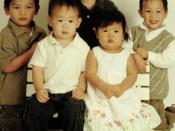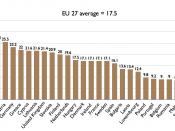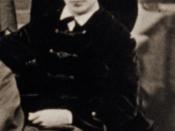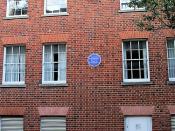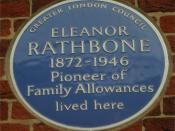After the First World War and throughout the 1920's various feminist organisations which had always held the view that women should be given equal status to that of men appeared to change their opinions completely in favour of a women's natural place being in the home. Many women like Eleanor Rathbone, Mary Stocks and Maude Royden who had been strong advocates that women should be treated as equal to men in all aspects of society and life such as employment starting promoting women to return to the home and fulfil their natural born duty, which is being a mother and a wife. Post-war feminist opinions and ideals appeared to have changed considerably to that of pre-war feminists.
The majority of feminist organisations primary concern was women being enfranchised, so when this was granted in the 1918 Representation of the People Act many groups found themselves divided over other issues.
While certain members in the organisations wished to carry on with the task of women receiving equal status to that of men, many other members were taking a different approach to feminism. They believed that women were different to men and should therefore aim to obtain acts and laws that would be useful to women like family allowances. Equalitarian feminists disagreed with these ideals as they felt these kinds of aims were bounding women more and more to the home and to a subservient role in society. Members within various feminist organisations began to divide on these issues and eventually many organisations spilt because of their differing views. Smaller feminist groups were established in place of the larger original organisations. Each group had slightly different views on what were worthy, beneficial causes to try and achieve for the female population. Due to large organisations becoming smaller feminism appeared to have lost large amounts of popularity within society. Women found it difficult to decide which group to support because they were so many and each group tried to offer some different and more beneficial to the women. Many women appeared uninterested by feminist organisations and what they were trying to achieve. 'Modern, young women know amazingly little of what life was like before the war, and show a strong hostility to the word 'feminism' and which they imagine it to connote.''War imposed masculine values upon society, thus reinvigorating notions of separate spheres. Because men fight wars and women stay at home, women are forced back into feminine roles of mother, nurturer and carer, which are themselves, symbolic of the values men imagine themselves to be defending. War made the government and society firmly believe that traditional roles in society should be upheld. Consequently after the war-ended women were urged by the government to give up their jobs for the returning soldiers while women returned to their rightful place, which was in the home. The majority of women accepted this and readily returned, with many being content to revert back to their traditional roles. Most women agreed with the notion that men should work and women should stay at home and only ever saw the war as a temporary measure. They wished to uphold tradition values, which were prevalent before the war. However if women wished to remain in their wartime jobs they were publicity frowned upon. Any women who tried to remain in their jobs experienced harsh treatment from society. They were depicted by society as trying to steal returning soldiers jobs, and were constantly abused in the press. 'As W. Keith pointed out in the Daily News in March 1921, an article titled "Dislike of women," "the attitude of the public towards women is more full of contempt and bitterness than had been the case since the suffragette outbreaks. ' The Government who wanted to remove women from their war- time jobs as quickly as possible achieved this with the introduction of the 1919 Restoration of the Pre-War Practices Act, which forced them to do so. 'By 1921, fewer women were 'gainfully employed,' according to the census of that year, than in 1911.' Although many women were content with returning to the home, countless numbers of women were forced to return to their tradition role of being in the home. Not only did the government urge women to return so did various feminist organisations. Their attitude about women's role in society was completely different to the views they held before the war. Feminists groups now deemed it acceptable for women to be purely wives and mothers and concentrate solely on their roles within the home. They argued that this was what women were best at doing; their body was designed for that role. Mary Stocks argued that 'the majority of women workers are only birds of passage in their trades. Marriage and the bearing and rearing of children are their most permanent occupations.' It many ways it seemed that these organisations were taking a step back for feminist rather than a step forward.
Many of the acts that were introduced during the 1920's made it increasing more difficult for women to work, especially once they were married. There were no objections to any of these acts from feminist groups, showing how different their objectives now were. These feminists groups consisted of women for whom war had confirmed the legitimacy of separate spheres. They campaigned for reforms to make the home more comfortable, safe, secure, and to enhance motherhood. For the majority of feminist groups their primary aim was to improve women's life in the home and as a wife and mother. They did succeed in getting various reforms passed throughout the 1920's like family allowances. However the majority of these acts just tied women to their traditional roles and bound them more intricately to the home, something the feminists had previously been trying to eradicate. Eleanor Rathbone led a group of feminists who were concerned with seeking enhanced privileges for women in the home. She believed that feminists 'should seek reforms related to women's special concerns, especially those involving motherhood, rather than seeking what men had. Family allowances paid to the mother, for example were more important than equal pay for women.' Equalitarian feminists viewed these women as 'new feminism' as it had so little to do with what they themselves stood for and were trying to achieve. Equalitarian feminists were presenting the case for granting women equal pay for equal work; Rathbone endorsed the common anti-feminist argument that men deserved higher pay then women because they had families to support. These new feminists were placing an increased insistence on women's natures, which encouraged traditional notions of femaleness. This made it increasingly more difficult for women to escape from these traditional roles. Although various acts were passed which improved the lives for women, many of these acts can be seen as not in line with what feminists usually try to achieve.
Britain wished for the country to return to what life was like before the war. Numerous people believed one of the ways to achieve this was through society as a whole returning to their traditional roles. This 'reconstruction' meant a return to traditional family life, which militated against female emancipation. Yet many of those most enthusiastic for a return to normality were women, including feminists. Even they agreed with this notion, so many feminists decided to stop trying to fight for equal rights if it meant society would return to 'normal'. 'As Cicely Hamilton, a committed feminist both before and after the war, observed in 1927, 'the peace in our time for which we all crave will mean a reaction, more or less strong, against the independence of women,'' The largest women's union, the National Federation of Women Workers after the war expressed their opinion that married women should ideally not have to work. 'Feminism soon became linked in the public mind not merely with sex war, a somewhat familiar concept, but with armed conflict, death and destruction. Feminism during the 1920's was seen by the nation as a painful reminder of the war period. For many Britons the feminist insistence on equality and the women's right to work and be able to participate in politics threatened the attempted return to normalcy and raised the idea of continued conflict in Britain after the Armistice. To be a feminist during this period was hugely unpopular with all members of society including women. The majority of the British public after the war was largely anti-feminist, making it even more undesirable for women to show their support for feminist groups. So most Britons, including feminists, looked to create peace and order n the public sphere of social, economic and political relations by imposing peace and order on the private sphere of sexual relations.
Certain feminists groups were still extremely concerned about sexual equality, campaigned for legal reform, equal access, equal pay, the removal of the marriage bar to employment, liberalisation of divorce laws, further electoral reform like the removal of the age bar. Feminist organisations such as the Women's Freedom League and the London and National Society for Women's Service continued throughout the 1920's. They pledged to continue working for the equal suffrage; it's programme-identified women's economic equality as its immediate priority. Winifred Holtby was a predominant feminist throughout the 1920's. She was still campaigning for women to receive these equal opportunities in society. She found it extremely difficult to understand especially after all the freedom women had been given during the war that the majority of women were content with keeping their tradition roles within society. 'are women themselves often the first to repudiate the movements of the past hundred and fifty years, which have gained them at least the foundations of political, economic, educational and moral equality?' She disliked the feminists who promoted staying at home and felt that these 'new feminists' were trapping women further and further back into the home. 'New Feminists referred to maternity as the 'most important of women's occupations.'' She believed that these women were inadvertently playing into the hands of those keen on restoring Victorian notions of public spheres.
Equality improvements for women were however still being achieved just after the war and during the 1920's. In 1918 the Eligibility of Women Act passes unopposed, enabling them to stand for Parliament, the Bastardy Law of 1872 were amended, increasing the amount a father could be made to be for his illegitimate child. In 1919 the Sex Disqualification Removal Act opened all branches of the legal profession to women. The Matrimonial Causes Act of 1923 eliminated the double standards of divorce; in 1925 the civil service was forced to admit women to its competitive examinations. The 1928 Representation of the People (Equal Franchise) Act granting women aged twenty-one and over the suffrage on the same basis as men, was key reform for feminists organisations. Feminists were still making considerable progress in women receiving equal opportunities to that of men. Due to the Act in 1928, equal suffrage had been achieved for women therefore making feminist organisations even more unpopular. Many felt there was little more they could accomplish. Many women who supported these egalitarian groups chose to now join the non-feminist organisations, which sought to teach women how to perform their traditional roles better, rather than continue in the feminist branches. Their popularity declined more rapidly as the 1920's went on.
The 1920's can clearly been seen as the demise of feminism. The feminist's organisations after the First World War changed their ideals and attitudes from the stance of women being given equal opportunities to one of promoting women back in the home to be a wife and mother. While they once aspired for women to be seen as equal to men, they now accepted that women were different and attempted to pass acts that would help women in terms of being a good mother rather than being able to work and receive the same pay as a man. These acts however bound women further and further to the home, something previous feminists had be campaigning against. Feminism was becoming less and less popular within women in society, without public support, it became increasingly more difficult for various feminist organisations, especially for the small minority of groups who were still fighting for women to receive equal opportunities. Britain wished for society to return to how it was before the war, feminists were a constant reminder for most people of the war period. This made feminism to all women in society an unappealing prospect, they too wanted society to return to 'normal' so many were happy to accept their reduced statues within society once again. The 'new' feminists had something which did appeal to women of the 1920's however their ideals and the reforms they campaigned for can often be described as anti-feminist. As Olive Banks pointed out, interwar feminism 'trapped women in the cult of domesticity from which earlier feminists had tried to free themselves.' While some feminist groups still fought for equal rights and gained considerable success, the majority of feminist organisations during the 1920's supported women being tied to the home. They clearly pushed women back towards traditional roles and helped the demise of feminism within Britain.
BibliographyS. K. Kent, Making Peace: The Reconstruction of Gender in Interwar Britain (Princeton, New Jersey, 1993) pp. 114-15.
G. J. DeGroot, Blighty: British Society in the Era of the Great War (London, 1996), p. 304.
S. K. Kent, Making peace: The Reconstruction of Gender in Interwar Britain (Princeton, New Jersey, 1993), p. 101.
S. K. Kent, 'The Politics of Sexual Difference: World War 1 and the Demise of British Feminism' Journal of British Studies, 27 (1988), p.238.
Ibid, p. 241.
H. L. Smith, British Feminism in the Twentieth Century (England, 1900), p. 48.
H. L. Smith, British Feminism in the Twentieth Century (England, 1990), p.70.
S. K. Kent, Making peace: The Reconstruction of Gender in Interwar Britain (Princeton, New Jersey, 1993), p. 91G. J. DeGroot, Blighty: British Society in the Era of the Great War (London, 1996), p. 306H. L. Smith, British Feminism in the Twentieth Century (England, 1990). P.48.
S. K. Kent, 'The Politics of Sexual Difference: World War 1 and the Demise of British Feminism,' The journal of British Studies, 27, (1988), p. 242.


